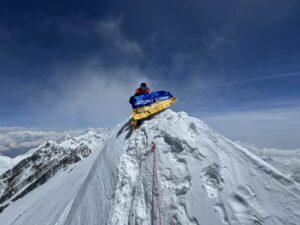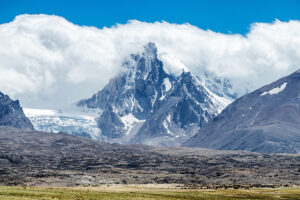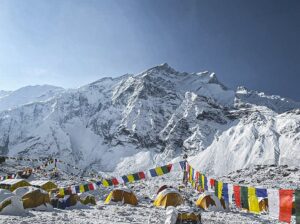About 150 climbers have summited Everest in the last two days. Of the 200 in Dhaulagiri’s Base Camp last week, only Carlos Soria and Topo Mena’s teams remain. The few trekkers in the Khumbu and Annapurna areas hurried back to town as soon as they heard about canceled international flights.
Now, an increasing number of foreigners are stranded in their hotels, working their contacts to find a way to leave the country. No scheduled international flights are running, but charters and cargo planes still fly in and out of Tribhuvan airport.
Also, Nepal keeps open contact with India. Two flights a week run between Kathmandu and Delhi. On the other hand, the airport closure has marooned a number of Indians transiting through Nepal to other international destinations. This workaround avoided the travel ban that most countries have imposed on India because of its COVID crisis. The Indian embassy is currently trying to repatriate its citizens.

A plane takes off from Kathmandu’s Tribhuvan airport. Photo: The Kathmandu Post
Special flights
For stranded tourists, Nepal’s Civil Aviation has permitted “special flights” for foreigners at the request of their embassies. The U.S. and Indian embassies have already arranged flights through Qatar and Turkish airlines, while a large Aeroflot plane will fly Russians back home, The Kathmandu Post reports.
Nepal’s Tourism Board estimates that there are currently 2,000 foreigners in Kathmandu. Five thousand more, currently in other regions, will join them in KTM in the next few weeks.
Some outfitters will just arrange a charter for their groups. Not surprisingly, the big-ticket clients currently in Everest Base Camp, still waiting for good weather to summit, will be among them.
“We expect the good weather to return by May 20 to 23,” Lukas Furtenbach told ExplorersWeb. “Afterward, we will get a charter flight to Dubai.”
Fresh from Dhaulagiri, a COVID-stricken Steffi Troguet is still in the hospital awaiting a negative PCR test to give her the all-clear. She hopes to join Jonatan García, Alex Txikon, and a Spanish trekking group that includes leader Sebastián Álvaro and Juanito Oiarzabal on a charter to Istanbul, from which they can return to Spain.
Unexpected or irresponsible?
Commenters have cited the apparent irresponsibility of those who went to Nepal at this time. But only three weeks ago, the situation looked very different. Nepal had vigorously encouraged foreigners to visit. PCRs and quarantines ensured that visitors didn’t bring the virus with them into the (then) clean mountain valleys.
Eventually, as COVID numbers continued to decrease, Nepal shrank the quarantine period. In so doing, they hoped to attract not only climbers but also trekkers who couldn’t afford to waste days locked down in a hotel.
Sebastián Álvaro feels that they have been kidnapped. “We have committed no crime and we have strictly followed all the measures imposed by Nepal’s government,” he said. “We have paid for our return tickets, and we hurried back the moment we heard that the country was closing, but we have been given no time or way to leave.”

Sebastian Alvaro in the Khumbu last week.
A perfect storm
Some visitors blame the authorities’ relaxed enforcement of safety measures. They also note the lack of care by some trekking and climbing groups, and the absence of tests for local porters, guides, and business owners.
Everyone, it seemed, flocked to the Khumbu and the Kali Gandaki as soon as tourism revived. Nepal issued a record 408 Everest permits, and a vast number of climbers, Sherpas, and other staff turned Everest Base Camp into a canvas city. Mobility was high, as locals visited relatives in villages and climbers visited each other. Hygiene control was difficult.
When India lapsed into its current crisis, Nepal’s government did nothing. On the contrary, the Department of Tourism kept issuing Everest permits. After an extremely difficult economic year, many in Nepal celebrated the return of tourism. But slipshod enforcement and the liberal issuance of climbing permits, as if all were really back to normal, created large groups in small spaces. Together, it became a perfect storm.






